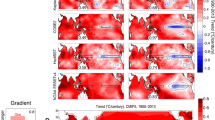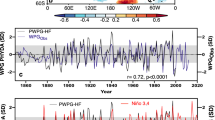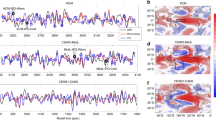Abstract
The equatorial Pacific zonal sea surface temperature (SST) gradient, known to be a pacemaker of global warming, has strengthened since the mid-twentieth century. However, the cause is controversial because a majority of Coupled Model Intercomparison Project Phase 5 (CMIP5) models suggest weakening of the zonal SST gradient from the past to the future. Reconciling this discrepancy is important for the climate change attribution and climate sensitivity assessment. Here we use the CMIP5 ensemble and large ensemble simulations by four climate models to show that the intensifying SST gradient observed during 1951–2010 could arise from internal climate variability. Models and members that simulate historical strengthening of the SST gradient commonly exhibit reversed future trends. Using these models as a constraint, the rate of global-mean temperature rise is amplified by 9–30%, with higher values occurring in low-emission scenarios, because internal variability has a greater impact when the externally forced response is smaller.
This is a preview of subscription content, access via your institution
Access options
Access Nature and 54 other Nature Portfolio journals
Get Nature+, our best-value online-access subscription
$29.99 / 30 days
cancel any time
Subscribe to this journal
Receive 12 print issues and online access
$209.00 per year
only $17.42 per issue
Buy this article
- Purchase on Springer Link
- Instant access to full article PDF
Prices may be subject to local taxes which are calculated during checkout




Similar content being viewed by others
Data availability
COBE-SST2, ERSSTv5, ICOADS and Kaplan SST data sets are all available from the NOAA/OAR/ESRL PSD website (https://www.esrl.noaa.gov/psd/data/gridded/). Two other SST data sets compiled at the Met Office Hadley Centre are available from https://www.metoffice.gov.uk/hadobs/. The CMIP5 model output analysed in this study is available from the Earth System Grid Federation (ESGF) server (https://esgf-node.llnl.gov/search/cmip5/). The CESM Large Ensemble project simulation output can be obtained from http://www.cesm.ucar.edu/projects/community-projects/LENS/data-sets.html. The MPI-ESM1.1 large ensemble data are available at the MPI Grand Ensemble project website (https://www.mpimet.mpg.de/en/grand-ensemble/). A part of the IPSL-CM6-LR and MIROC6 large ensemble simulation data can be downloaded from ESGF47,48, but the full data sets are available upon request.
Code availability
The Fortran codes used for creating main plots in this study are available at https://ccsr.aori.u-tokyo.ac.jp/~hiro/sst_trends/.
References
Bjerknes, J. Atmospheric teleconnections from the equatorial Pacific. Mon. Weather Rev. 97, 162–172 (1969).
Jin, F.-F. Tropical ocean–atmosphere interaction, the Pacific cold tongue, and the El Niño Southern Oscillation. Science 274, 76–78 (1996).
Timmermann, A. et al. El Niño–Southern Oscillation complexity. Nature 559, 535–545 (2018).
Solomon, A. & Newman, M. Reconciling disparate twentieth-century Indo-Pacific Ocean temperature trends in the instrumental record. Nat. Clim. Change 2, 691–699 (2012).
IPCC Climate Change 2013: The Physical Science Basis (eds Stocker, T. F. et al.) (Cambridge Univ. Press, 2013).
Taylor, K. E., Stouffer, R. J. & Meehl, G. A. An overview of CMIP5 and the experiment design. Bull. Am. Meteor. Soc. 93, 485–498 (2012).
Collins, M. et al. The impact of global warming on the tropical Pacific Ocean and El Niño. Nat. Geosci. 3, 391–397 (2010).
Kim, S. T. et al. Response of El Niño sea surface temperature variability to greenhouse warming. Nat. Clim. Change 4, 786–790 (2014).
Clement, A., Seager, R., Cane, M. A. & Zebiak, S. E. An ocean dynamical thermostat. J. Clim. 9, 2190–2196 (1996).
Xie, S.-P. et al. Global warming pattern formation: sea surface temperature and rainfall. J. Clim. 23, 966–986 (2010).
Held, I. M. & Soden, B. J. Robust responses of the hydrological cycle to global warming. J. Clim. 19, 5686–5699 (2006).
Vecchi, G. A. et al. Weakening of tropical Pacific atmospheric circulation due to anthropogenic forcing. Nature 441, 73–76 (2006).
Chadwick, R., Boutle, I. & Martin, G. Spatial patterns of precipitation change in CMIP5: why the rich do not get richer in the tropics. J. Clim. 26, 3803–3822 (2013).
Coats, S. & Karnauskas, K. B. Are simulated and observed twentieth century tropical Pacific sea surface temperature trends significant relative to internal variability? Geophys. Res. Lett. 44, 9928–9937 (2017).
England, M. H. et al. Recent intensification of wind-driven circulation in the Pacific and the ongoing warming hiatus. Nat. Clim. Change 4, 222–227 (2014).
Deser, C., Phillips, A. S. & Alexander, M. A. Twentieth century tropical sea surface temperature trends revisited. Geophys. Res. Lett. 37, L10701 (2010).
Bordbar, M. H., Martin, T., Latif, M. & Park, W. Role of internal variability in recent decadal to multidecadal tropical Pacific climate changes. Geophys. Res. Lett. 44, 4246–4255 (2017).
Andrews, T. et al. Accounting for changing temperature patterns increases historical estimates of climate sensitivity. Geophys. Res. Lett. 45, 8490–8499 (2018).
Ceppi, P. & Gregory, J. M. Relationship of tropospheric stability to climate sensitivity and Earth’s observed radiation budget. Proc. Natl Acad. Sci. USA 114, 13126–13131 (2017).
Zhou, C., Zelinka, M. D. & Klein, S. A. Impact of decadal cloud variations on the Earth’s energy budget. Nat. Geosci. 9, 871–874 (2016).
Dong, Y., Proistosescu, C., Armour, K. C. & Battisti, D. S. Attributing historical and future evolution of radiative feedbacks to regional warming patterns using a Green’s function approach: the preeminence of the western Pacific. J. Clim. 32, 5471–5491 (2019).
Fyfe, J. C. et al. Making sense of the early-2000s warming slowdown. Nat. Clim. Change 6, 224–228 (2016).
Luo, J.-J., Wang, G. & Dommenget, D. May common model biases reduce CMIP5’s ability to simulate the recent Pacific La Niña-like cooling? Clim. Dynam. 50, 1335–1351 (2018).
Seager, R. et al. Strengthening tropical Pacific zonal sea surface temperature gradient consistent with rising greenhouse gases. Nat. Clim. Change 9, 517–522 (2019).
Chung, E.-S. et al. Reconciling opposing Walker circulation trends in observations and model projections. Nat. Clim. Change 9, 405–412 (2019).
Power, S. et al. Inter-decadal modulation of the impact of ENSO on Australia. Clim. Dyn. 15, 319–324 (1999).
Henley, B. J. et al. Spatial and temporal agreement in climate model simulations of the Interdecadal Pacific Oscillation. Environ. Res. Lett. 12, 044011 (2017).
Meehl, G., Hu, A. & Teng, H. Initialized decadal prediction for transition to positive phase of the Interdecadal Pacific Oscillation. Nat. Commun. 7, 11718 (2016).
Kosaka, Y. & Xie, S.-P. The tropical Pacific as a key pacemaker of the variable rates of global warming. Nat. Geosci. 9, 669–673 (2016).
Bordbar, M. H. et al. Uncertainty in near-term global surface warming linked to tropical Pacific climate variability. Nat. Commun. 10, 1990 (2019).
Kociuba, G. & Power, S. B. Inability of CMIP5 models to simulate recent strengthening of the Walker circulation: implications for projections. J. Clim. 28, 20–35 (2015).
Takahashi, C. & Watanabe, M. Pacific trade winds accelerated by aerosol forcing over the past two decades. Nat. Clim. Change 6, 768–772 (2016).
McGregor, S. et al. Recent Walker circulation strengthening and Pacific cooling amplified by Atlantic warming. Nat. Clim. Change 4, 888–892 (2014).
Hirahara, S., Ishii, M. & Fukuda, Y. Centennial-scale sea surface temperature analysis and its uncertainty. J. Clim. 27, 57–75 (2014).
Rayner, N. A. et al. Global analyses of sea surface temperature, sea ice, and night marine air temperature since the late nineteenth century. J. Geophys. Res. 108, 4407 (2003).
Kennedy, J. J., Rayner, N. A., Smith, R. O., Saunby, M. & Parker, D. E. Reassessing biases and other uncertainties in sea-surface temperature observations since 1850. Part 1: measurement and sampling errors. J. Geophys. Res. 116, D14103 (2011).
Huang, B. et al. Extended reconstructed sea surface temperature, version 5 (ERSSTv5): upgrades, validations, and intercomparisons. J. Clim. 30, 8179–8205 (2017).
Woodruff, S. D. et al. ICOADS release 2.5: extensions and enhancements to the surface marine meteorological archive. Int. J. Climatol. 31, 951–967 (2011).
Kaplan, A. et al. Analyses of global sea surface temperature 1856–1991. J. Geophys. Res. 103, 18567–18589 (1998).
Ishii, M. & Kimoto, M. Reevaluation of historical ocean heat content variations with time-varying XBT and MBT depth bias corrections. J. Oceanogr. 65, 287–299 (2009).
Kay, J. E. et al. The Community Earth System Model (CESM) large ensemble project: a community resource for studying climate change in the presence of internal climate variability. Bull. Am. Meteor. Soc. 96, 1333–1349 (2015).
Maher, N. et al. The Max Planck Institute grand ensemble: enabling the exploration of climate system variability. J. Adv. Model. Earth Sys. 11, 1–21 (2019).
Tatebe, H. et al. Description and basic evaluation of simulated mean state, internal variability, and climate sensitivity in MIROC6. Geo. Model Dev. 12, 2727–2765 (2019).
Boucher, O. et al. Presentation and evaluation of the IPSL-CM6A-LR climate model. J. Adv. Model. Earth Sys. 12, e2019MS002010 (2020).
Eyring, V. et al. Overview of the Coupled Model Intercomparison Project Phase 6 (CMIP6) experimental design and organization. Geosci. Model Dev. 9, 1937–1958 (2016).
Kimoto, M. & Ghil, M. Multiple flow regimes in the Northern Hemisphere winter. Part I: methodology and hemispheric regimes. J. Atmos. Sci. 50, 2625–2643 (1993).
Boucher, O. et al. IPSL-CM6A-LR model output prepared for Coupled Model Intercomparison Project Phase 6 (CMIP6) historical run. Earth System Grid Federation https://doi.org/10.22033/ESGF/CMIP6.5195 (2018).
Tatebe, H. et al. MIROC6 model output prepared for Coupled Model Intercomparison Project Phase 6 (CMIP6) historical run. Earth System Grid Federation https://doi.org/10.22033/ESGF/CMIP6.5603 (2018).
Acknowledgements
We acknowledge the modelling groups, the PCMDI and the WCRP’s WGCM for their efforts in making the CMIP5 multi-model data set available. We also thank T. Suzuki for processing CMIP5 ocean temperature data. M.W., Y.K. and H.T. were supported by Grant-in-Aid 26247079 and the Integrated Research Program for Advancing Climate Models (JPMXD0717935457) from the Ministry of Education, Culture, Sports, Science and Technology (MEXT), Japan. J.-L.D. was supported by the European Union Horizon 2020 project #820829. T.M. acknowledges funding from European Research Council grant #770765 and European Union Horizon 2020 project #820829.
Author information
Authors and Affiliations
Contributions
M.W. designed the research and wrote the paper. H.T. conducted the MIROC large ensemble experiments. J.-L.D., Y.K. and T.M. helped analyse the large ensemble simulations. All authors discussed the results and commented on the manuscript.
Corresponding author
Ethics declarations
Competing interests
The authors declare no competing interests.
Additional information
Peer review information Nature Climate Change thanks Dong Eun Lee and the other, anonymous, reviewer(s) for their contribution to the peer review of this work.
Publisher’s note Springer Nature remains neutral with regard to jurisdictional claims in published maps and institutional affiliations.
Supplementary information
Supplementary Information
Supplementary Figs. 1–15 and Table 1.
Rights and permissions
About this article
Cite this article
Watanabe, M., Dufresne, JL., Kosaka, Y. et al. Enhanced warming constrained by past trends in equatorial Pacific sea surface temperature gradient. Nat. Clim. Chang. 11, 33–37 (2021). https://doi.org/10.1038/s41558-020-00933-3
Received:
Accepted:
Published:
Issue Date:
DOI: https://doi.org/10.1038/s41558-020-00933-3
This article is cited by
-
Historical changes in wind-driven ocean circulation drive pattern of Pacific warming
Nature Communications (2024)
-
Nature and impact of extremely severe cyclone Tauktae over India
Discover Oceans (2024)
-
Satellite-observed strong subtropical ocean warming as an early signature of global warming
Communications Earth & Environment (2023)
-
Ocean-forcing of cool season precipitation drives ongoing and future decadal drought in southwestern North America
npj Climate and Atmospheric Science (2023)
-
Climate processes and drivers in the Pacific and global warming: a review for informing Pacific planning agencies
Climatic Change (2023)



